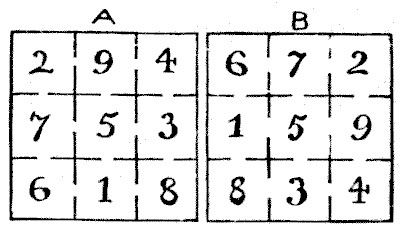(related to Problem: Nine Jolly Gaol Birds)
There is a pitfall set for the unwary in this little puzzle. At the start, one man is allowed to be placed on the shoulders of another, so as to give always one empty cell to enable the prisoners to move about without any two ever being in a cell together. The two united prisoners are allowed to add their numbers together, and are, of course, permitted to remain together at the completion of the magic square. But they are obviously not compelled so to remain together, provided that one of the pairs on his final move does not break the condition of entering a cell already occupied. After the acute solver has noticed this point, it is for him to determine which method is the better one — for the two to be together at the count or to separate. As a matter of fact, the puzzle can be solved in seventeen moves if the men are to remain together; but if they separate at the end, they may actually save a move and perform the feat in sixteen! The trick consists in placing the man in the center on the back of one of the corner men, and then working the pair into the center before their final separation.

Here are the moves for getting the men into one or other of the above two positions. The numbers are those of the men in the order in which they move into the cell that is for the time being vacant. The pair is shown in brackets:—
The first and second solutions produce Diagram $A;$ the second and third produce Diagram $B.$ There are only sixteen moves in every case. Having found the fewest moves, we had to consider how we were to make the burdened man do as little work as possible. It will at once be seen that as the pair have to go into the center before separating they must take at fewest two moves. The labor of the burdened man can only be reduced by adopting the other method of solution, which, however, forces us to take another move.
This eBook is for the use of anyone anywhere in the United States and most other parts of the world at no cost and with almost no restrictions whatsoever. You may copy it, give it away or re-use it under the terms of the Project Gutenberg License included with this edition or online at http://www.gutenberg.org. If you are not located in the United States, you'll have to check the laws of the country where you are located before using this ebook.